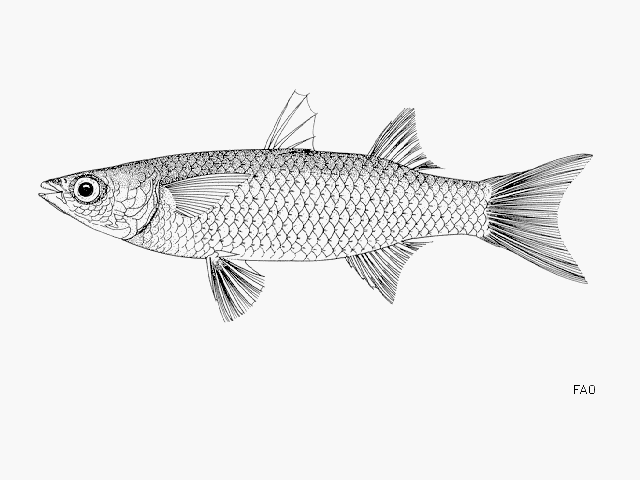|
Dorsal spines (total): 5-5; Dorsal soft rays (total): 8-9; Anal spines: 3-3; Anal soft rays: 8-9. Diagnosis: 8-9 anal soft rays; anal fin and lower lobe of caudal fin whitish or greyish (Ref. 57400). Body with ctenoid scales except for anterior predorsal scales which are cycloid and extend to anterior nostril or slightly beyond (Ref. 81659). Scales numerous (Ref. 57400), not large, 33-41 in a longitudinal series (excluding scales on caudal fin base), 11-14 scale rows between pelvic and first dorsal fin (Ref. 81659). 5-8 mucous canals on scales in front of 1st dorsal fin (only 1, less often 2 or 3, in other Liza species (Ref. 57400). Posterior end of maxilla sigmoid, curved down over premaxilla; serrate, anteroventral edge of lachrymal distinctly concave; pharyngobranchial organ with 1-2 valves, anteroventral valve a moderate size, semi-lunate flap, posterior valve usually vestigial, as a small nodule or, at most, a low papillate fold, and may be absent (Ref. 81659).
Description: body rather elongate (Ref. 57400, 81659), rather slender, reaching its greatest depth at level of 1st dorsal-fin origin (Ref. 57400). Head large; interorbital space almost flat; no adipose eyelid (Ref. 57400). Snout more or less pointed (Ref. 81659). Upper lip thin, not ornamented (Ref. 57400). Upper lip with outer row of close-set teeth, with slightly flattened, blunt unicuspid tips (Ref. 81659). 1-3 inner rows of teeth may be present (Ref. 57400, 81659), usually one row, sometimes no inner rows visible (Ref. 81659). Inner rows well separated from outer row, and teeth may be bicuspid and usually smaller and more widely spaced than outer row teeth; lower lip usually without teeth, rarely, outer margin of lip with sparse, minute ciliiform teeth; angle of mouth at dentary symphysis 90° or more, but usually less obtuse than in L. grandisquamis and L. falcipinnis (Ref. 81659). Hind end of upper jaw reaching a vertical line passing between posterior nostril and anterior eye margin; maxillary partially visible below corner of mouth when closed (Ref. 57400). In specimens >30 mm SL, some scales may have several radial grooves: 1-14 grooves on predorsal scales, 1-6 on interdorsal scales, 1-4 on scales of dorsal and ventral parts of caudal peduncle, 1-5 on opercular and infraorbital scales, and 1-2 on some scales on ventral parts of body; scales on lateral parts of flanks usually with one groove (Ref. 81659). Origin of 1st dorsal fin equidistant from snout tip and caudal-fin base (Ref. 57400). Second dorsal fin with 9 segmented rays (Ref. 81659). Anal fin with 3 spines (Ref. 81659) and 9 (rarely 8) segmented rays (Ref. 57400) in adults (1st spine very short and usually hidden by overlying scales)(Ref. 81659). Anal fin usually with 2 spines and 10 segmented rays in juveniles <30 mm SL (Ref. 81659). Anterior areas and bases of 2nd dorsal and anal fins covered with some scales (Ref. 57400). No axillary process (Ref. 57400). Pectoral fin 81-105% of head length, with 1 short, unsegmented ray dorsally and 14-17 (usually 15 or 16) longer, segmented rays; 4-7 (usually 6) pyloric caeca, not bifurcate, ventral 2-3 caeca usually longer than dorsal caeca (Ref. 81659). Dorsal scales in front of 1st dorsal fin with 5-8 mucous canals (in specimens longer than 12 cm SL)(Ref. 57400).
Coloration: brownish dorsally; approximately 6 vague, darkish bands on upper part of flanks; silvery ventrally; yellowish gold spot posterodorsally on opercle; pelvic fins pale; other fins dusky, especially anterior parts of second dorsal and anal fins and distal parts of caudal fin; anterodorsal parts of pectoral fins speckled with fine black pigmentation (Ref. 81659). |
| Inhabit shallow coastal waters (Ref. 27121), including estuaries (Ref. 2683, 57400, 81659), lagoons (Ref. 57400), tidal rivers (Ref. 3573), freshwater and supersaline environments (Ref. 81659). Feed on plankton and detritus (Ref. 28587). Oviparous, eggs are pelagic and non-adhesive (Ref. 205). Shows a remarkable adaptation to hyperhaline environments (up to 97‰ in the Sine Saloum in Senegal)(Ref. 57400). Specimens from tropical East Atlantic reaching maximum of 280 mm SL and common to 180 mm SL (Ref. 81659). |

